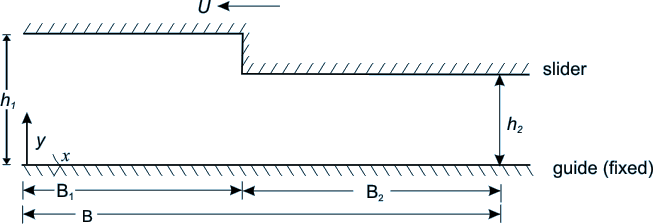|
Exercise Problems - Chapter 8
1. Water flows between two very large horizontal parallel flat plates 30 mm apart. If the average velocity of water is 0.2 m/s, what is the shear stress
(a) at the lower plate and
(b) at the middle plane?
Take

(a) 0.022 N/m2 (b) 0 2. A viscous fluid flows steadily, parallel to the axis in the annular space between two coaxial cylinders having radii r1 and r2 respectively. Show that the volumetric flow rate is given by

where n=r2/r1
3. An endless belt passes upward through a chemical both with speed V and drags a layer of liquid of thickness H, density ρ, and viscosity μ . Gravity pulls the liquid down, however, the upward movement of the belt keeps it from running off. Assuming laminar and fully developed flow, solve the velocity distribution across the layer of liquid, if the atmosphere exerts no-shear on its surface. Also determine the rate at which the liquid is being dragged up by the belt. 4. Derive a formula for the terminal velocity of a sphere with Re (based on the diameter) much less than 1. Apply the result to the settlement speed of blood cells in plasma, using a radius of 3 ×10-3 mm for the cell, a difference of densities between cell and the plasma of 0.07 ×10-6 kg/mm3, a plasma viscosity of 1.27 ×10-3 Ns/m2
This problem should be considered as a take-home assignment
5. Refer to Figure 27.4. This problem illustrates the secret of the strength of cello-tape joints.

Figure 27.4
A disc of radius r is at a uniform distance h from a large flat plate, and the gap h is filled with a viscous liquid. The disc moves upwards at v =dh/dt, in response to a central force F. Due to the symmetry of the problem (in the θ direction), the governing equations are

| Continuity: |
 |
| momentum: |
 |
a) Show that if  and and  inertia terms can be neglected in the momentum equations and we get the following : inertia terms can be neglected in the momentum equations and we get the following :
Continuity Equation remains unchanged 
b)
Solve these differential equations to get

c)
Estimate F if R=1 cm,  h =0.1 mm h =0.1 mm 
6.Find the load that the following step bearing (Figure 27.5) can carry:

Figure 27.5
The gap is uniform (=h1 ) over length B1 and also uniform  over length B2 . over length B2 .
To
view the recap, click next button or select from left-hand-side. |
|